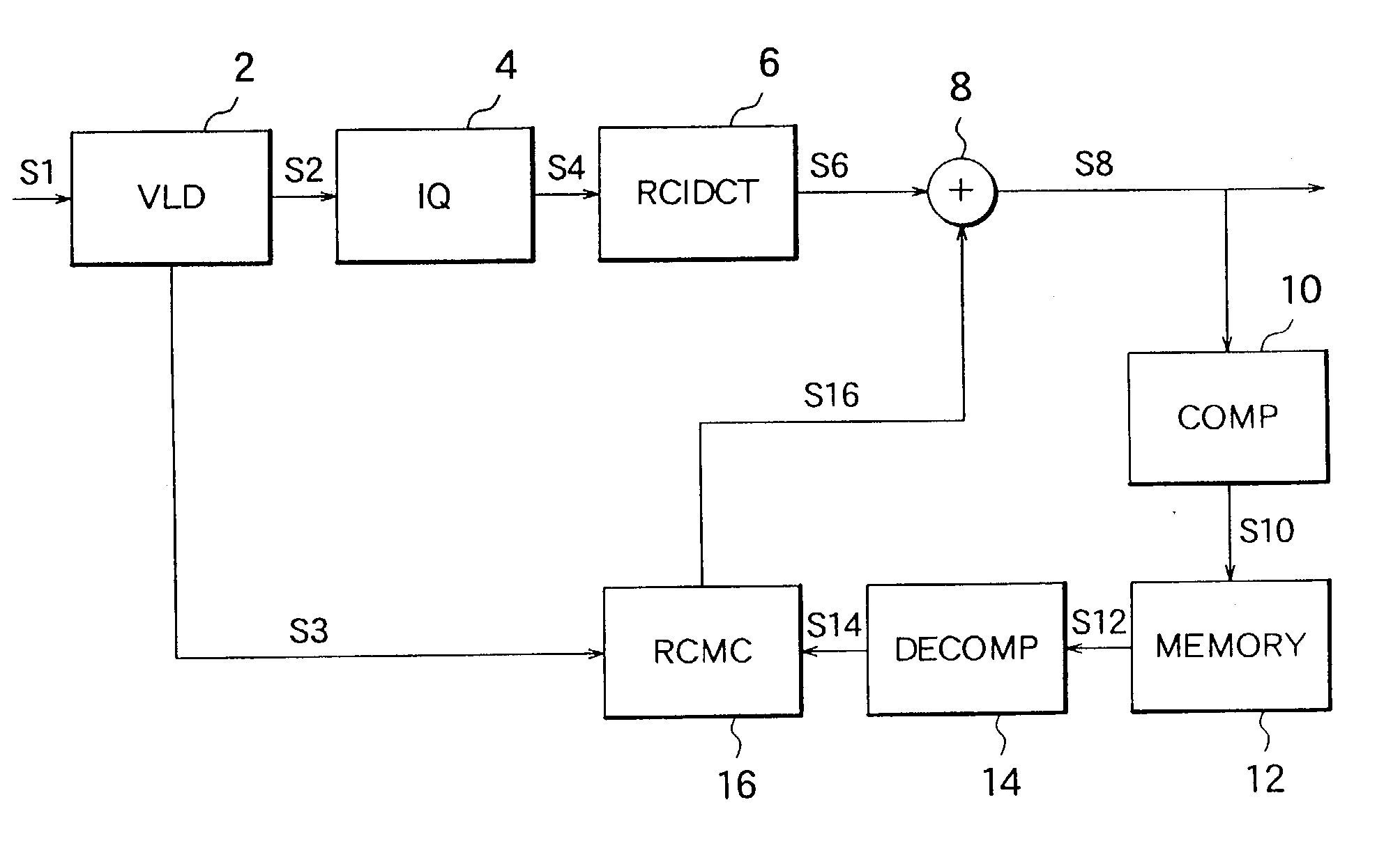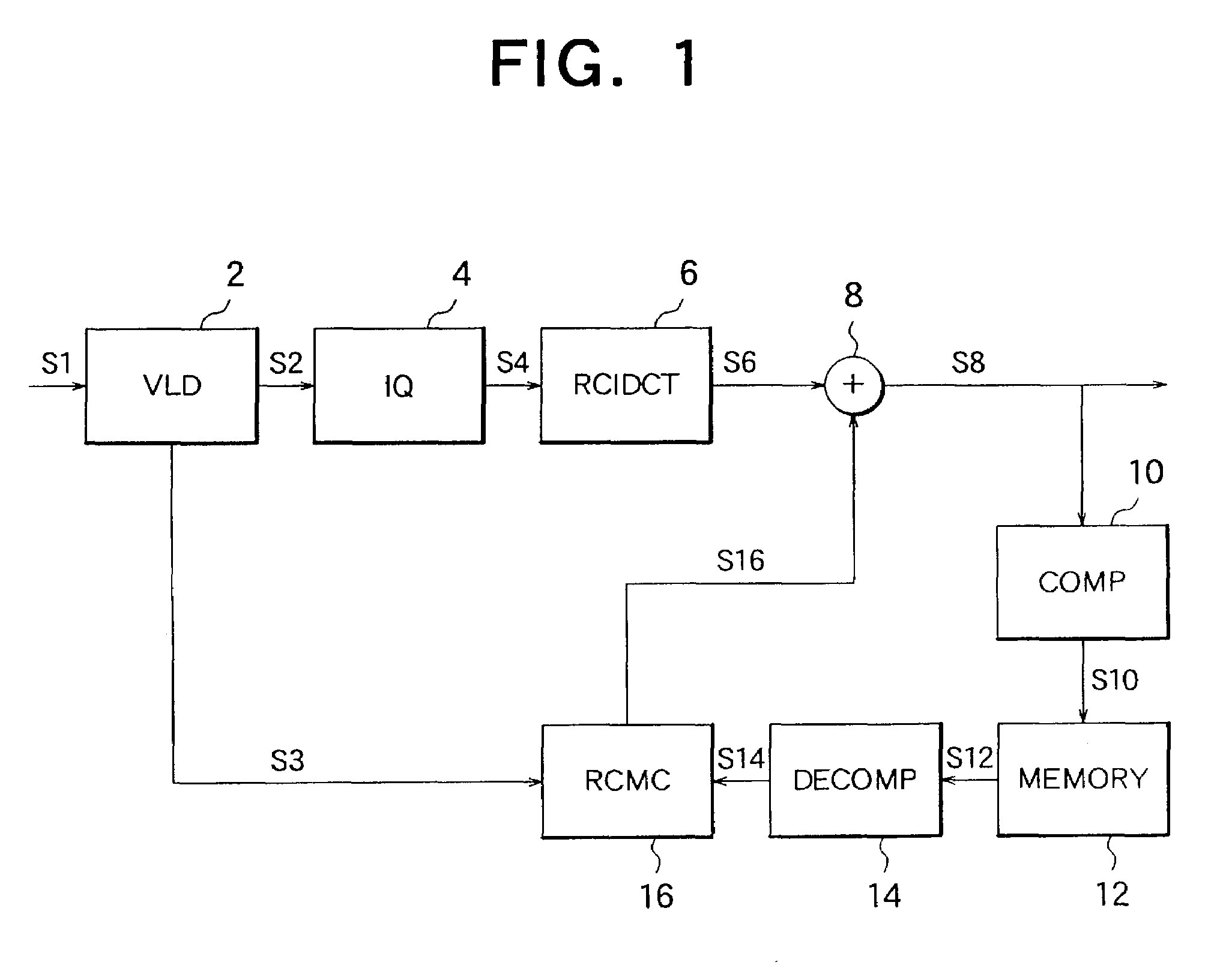Moving-picture coding and decoding method and apparatus with reduced computational cost
a technology of moving pictures and computational cost reduction, applied in the field of moving picture coding and decoding methods and apparatuses, can solve the problems of high computational cost, other costs, and significant cost in the idct, and achieve the effect of reducing memory requirements
- Summary
- Abstract
- Description
- Claims
- Application Information
AI Technical Summary
Benefits of technology
Problems solved by technology
Method used
Image
Examples
first embodiment
[0102]Next, the operation of the first embodiment will be described.
[0103]The variable-length decoder 2 and inverse quantizer 4 operate according to conventional variable-length decoding and dequantization procedures, detailed descriptions of which will be omitted.
[0104]The resolution-converting IDCT processor 6 operates, for example, as follows. First, the values y(k) defined in equation (7) above are obtained by performing matrix operation (8) on an eight-by-eight block of DCT coefficients. Each y(k) is equal to the average value of two consecutive pixel values x(2k) and x(2k+1), so this operation is equivalent to a horizontal IDCT followed by horizontal down-sampling by a factor of two. Next, a conventional vertical IDCT is carried out on the down-sampled values to obtain the first picture signal S6, without further down-sampling. The total amount of picture data in the first picture signal S6 is thus reduced by a factor of two, and the amount of necessary computation is also red...
second embodiment
[0115]Next, a second embodiment will be described.
[0116]Referring to FIG. 2, the second embodiment adds a low-pass filter (LPF) 18 to the configuration of the first embodiment. The low-pass filter 18 filters the output picture signal S8 to obtain a filtered output signal S18. The low-pass filter 18 operates only on pictures coded by intra-frame coding, and on the succeeding few predictively coded pictures, using predetermined initial filter coefficients for the intra-frame-coded picture, and successively weaker filter coefficients for the succeeding few predictively coded pictures or inter-frames.
[0117]As one example of filter coefficients that may be used, in an intra-frame-coded picture or intra-frame, if X, Y, and Z are three consecutive pixel values, the filter 18 replaces Y by the following value
(X+2Y+Z) / 4
[0118]The filter coefficients (1 / 4, 2 / 4, 1 / 4) in this case can be expressed more compactly by the notation (1, 2, 1) / / 4. An example of the complete set of coefficients used by...
third embodiment
[0126]Next, a third embodiment will be described.
[0127]Referring to FIG. 4, the third embodiment is a moving-picture coder comprising a subtractor 24, a DCT processor 26, a quantizer (Q) 28, a variable-length coder (VLC) 30, an inverse quantizer 32, a resolution-converting IDCT processor 34, an adder 36, a memory 38, a resolution-converting motion estimator (RCME) 40, and a resolution-converting motion compensator (RCMC) 42.
[0128]The subtractor 24 receives a digitized moving-picture input signal S22 comprising pictures to be coded by intra-frame or inter-frame coding. For inter-frame coding, the subtractor 24 subtracts a predicted picture S42 supplied by the resolution-converting motion compensator 42 and outputs a difference picture signal S24. For intra-frame coding, this picture signal S24 is identical to the input signal S22.
[0129]The DCT processor 26 performs a conventional discrete cosine transform on the picture signal S24 received from the subtractor 24, without performing r...
PUM
 Login to View More
Login to View More Abstract
Description
Claims
Application Information
 Login to View More
Login to View More - R&D
- Intellectual Property
- Life Sciences
- Materials
- Tech Scout
- Unparalleled Data Quality
- Higher Quality Content
- 60% Fewer Hallucinations
Browse by: Latest US Patents, China's latest patents, Technical Efficacy Thesaurus, Application Domain, Technology Topic, Popular Technical Reports.
© 2025 PatSnap. All rights reserved.Legal|Privacy policy|Modern Slavery Act Transparency Statement|Sitemap|About US| Contact US: help@patsnap.com



